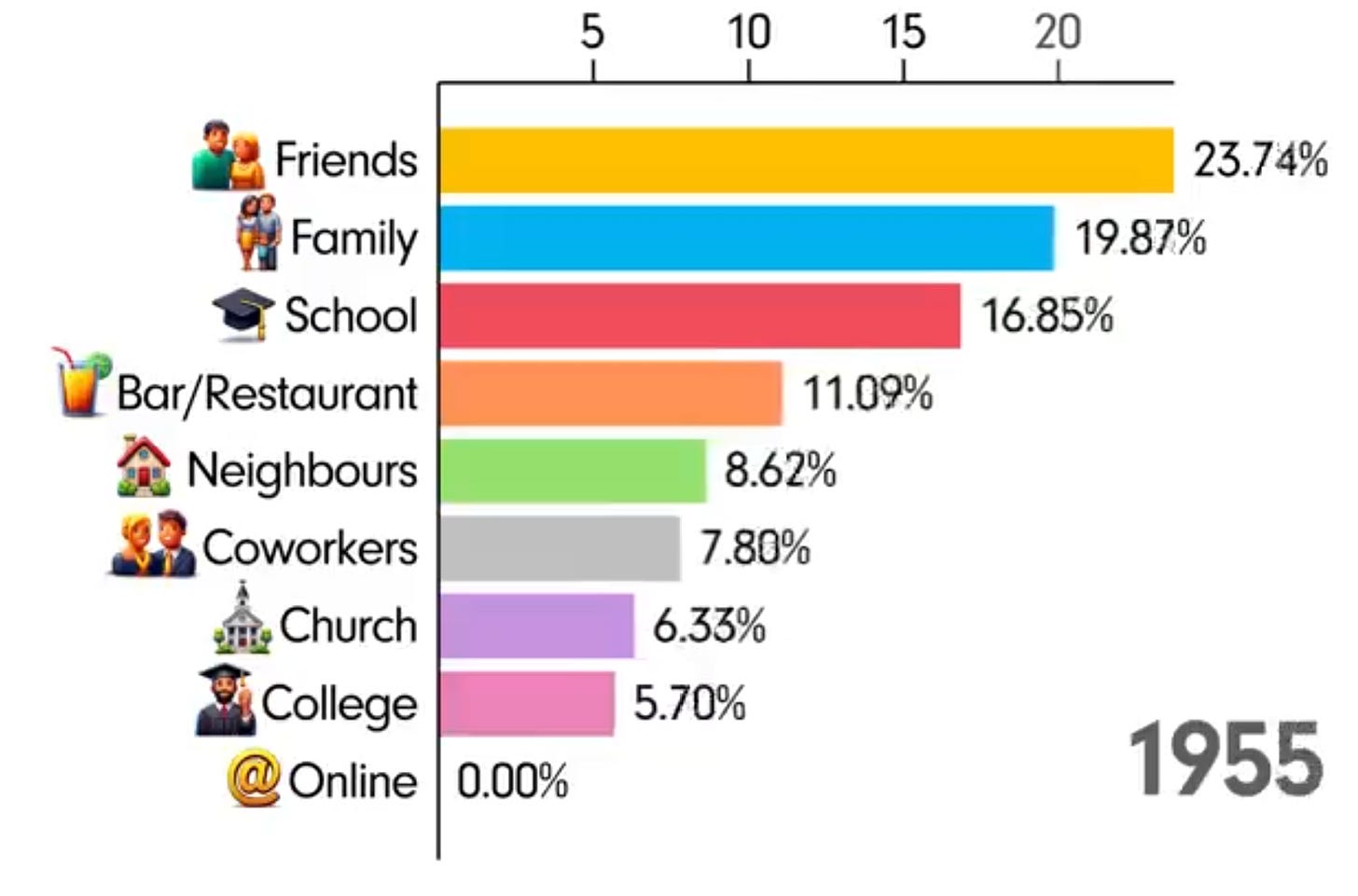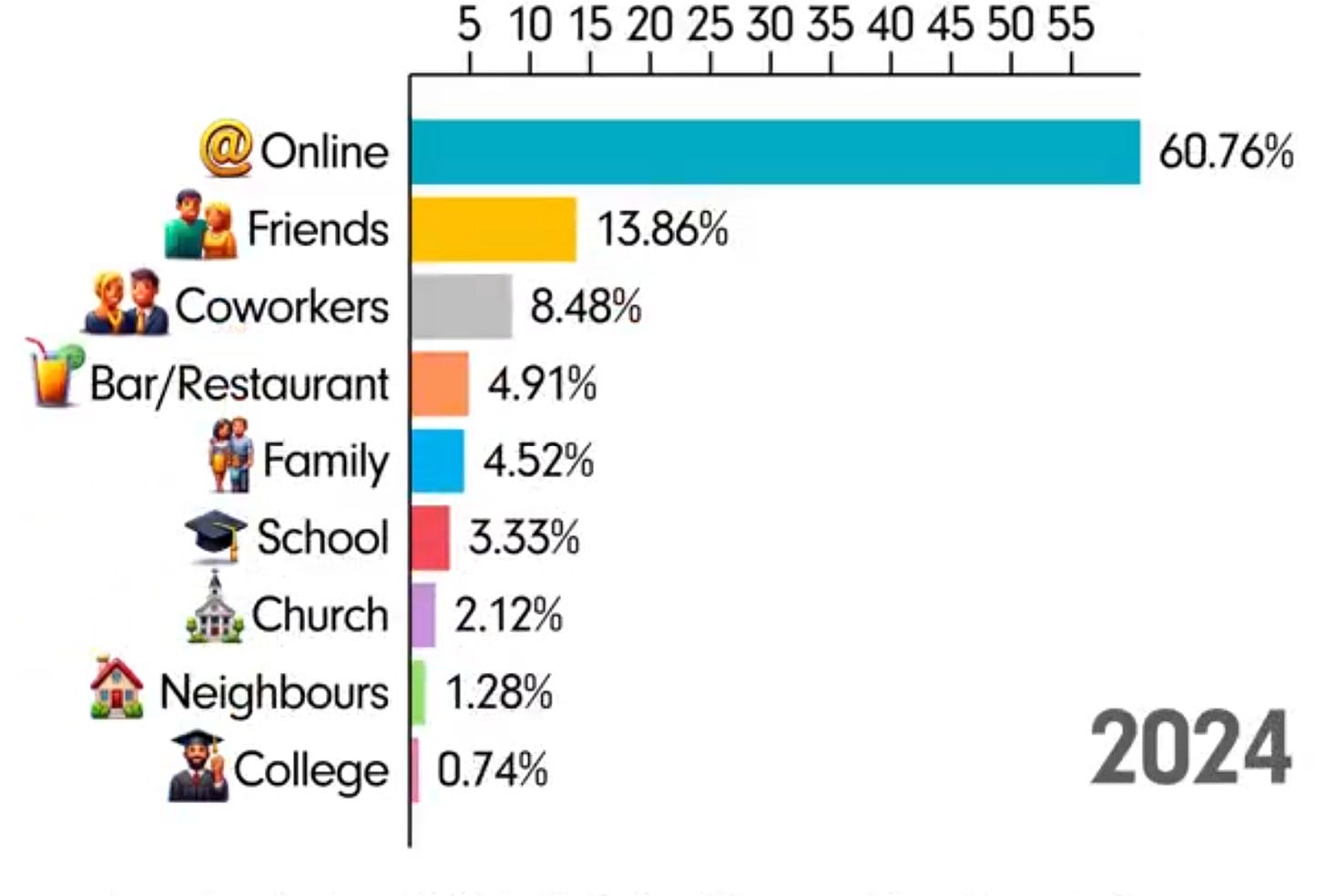
It doesn’t take much to realize just how much has changed in my lifetime, and yet on occasion I’m still smacked across the face with a new way of thinking about such things.
In this case, it was a random scroll through X/Twitter, right as I was about to shut my laptop for the day. A time-lapse graph caught my eye, and for days I haven’t been able to look away.
After watching it the first few times, I carried my laptop over to where my wife was sitting and lingered until she looked up. “You have to watch this right now!” I said excitedly as I clumsily shoved my computer onto her desk.
She watched with fascination (perhaps not quite as much as me) as the years ticked by, starting with 1930 and ending with 2024. With every year, the graph morphed and showed a change in how couples met.
We might as well all watch it together now.
In case you didn’t want to click the link I will divide the time lapse into larger chunks of time here, roughly every generation, to show how this single one-minute video has defined almost a century of how we are living and loving better than anything else I could imagine.
1930: So here’s where we start, and we immediately see the influence of both institutions and the limited range of where you might meet someone.
In 1930, the U.S. population was pretty closely split between urban (56%) and rural (44%). Both of my maternal grandparents were born around this time in rural parts of North Dakota and Minnesota, respectively. My grandmother, born in 1932, lived on a farm where at least for part of her early life there was no electricity.
These days, it is an 80/20 split with urban making up the vast majority of the population.
And we see that almost half of people in 1930 either met through family or in “school,” which I take to mean before college since there is a separate category for college.
Another 30% met through neighbors or friends, plus 10% through church. Those are all very limited population groups — especially for the nearly half of the population living in a rural area.
But they are also well-vetted, right? Couples in 1930 were meeting through trusted people, often older than them or at least peers.
And not a single couple meeting online. Strange.
1955: Just 25 years later, we see some pretty big changes lot long after my grandparents were married.
Friends, who made up the No. 3 spot in the 1930 graph, are now the No. 1 way couples are meeting.
Making connections through family is still important but less so. Same goes for finding your soulmate in high school.
By overall share, about 5% fewer couples are meeting at church. But they are making up for it by about 5% more couples meeting at bars and restaurants. And people are meeting more at work or through co-workers.
People’s worlds are changing, but still not a single couple that met online. Strange.
1980: Now we see couples meeting through friends with almost twice the frequency of any other method.
We also see the family — formerly the No. 1 way to meet — is now in roughly a three-way tie for a distant second place with co-workers and bars/restaurants.
People’s lives are broadening even further and they are trusting their chosen networks (or even their own intuition plus the seeming randomness of meeting at a bar/restaurant) significantly more than family.
This is right in the range of when my parents met in college, though that was still somewhat of an anomaly (6.46%) back then.
They did not meet online. Not a single couple did in 1980. Strange.
2000: The story here is pretty similar to what it was 20 years prior.
Friends still make up by far the largest share of sources for how couples met; my wife and I, who met at a party hosted by a mutual friend in early 2001, are contributors to that statistic during this era.
Co-workers, who were basically insignificant in the game of love when this graph began in 1930, are now in the No. 2 position.
Mostly we see a holding pattern with one notable exception: Down at the bottom, albeit at less than 5%, we see the early adopter couples who met online.
This was largely from some of the first online dating platforms. Match.com started in 1995 and others followed. Back then, though, there was still a stigma about having met online.
Things were going to change quickly.
2024: Fast-forward to today, and we find that more than 60% of couples met online.
This is a staggering change in just a generation, and its explanation requires a bit of a deeper dive.
The figure is not limited to people who met on a dating app, but instead it reveals just how “online” we are these days.
The number of couples meeting in every other way was roughly cut in half (or more) from 2000 to 2024, but think about how digital life has become a part of or proxy for so many other things.
Americans have far fewer close friends now than they did 30 years ago. Online communities, including social media, have filled that void.
The Covid-19 pandemic accelerated the trend of remote work, meaning co-workers interact far more online than they did previously.
During Covid (also before and after, but especially during), social media and other online platforms became gathering places that might have traditionally been reserved for bars and restaurants (think: sporting events, Academy Awards watch parties).
The influence of families, neighbors and churches in forming couples went from about a combined 45% in 1930 to roughly 8% this year.
More than any single trend, though, I would say there is this: The digital age has expanded options in ways that were unfathomable just a generation or two ago (and certainly compared to 1930).
Your dating pool is now “everyone in the world” or at least everyone online. Couples from all over the world can find each other, and technology helps them stay connected even if there is a physical distance.
Individual choice is a wonderful thing, and there has never been more of it on a broad scale.
At the same time, the digital age has contributed to what the U.S. Surgeon General termed in 2023 an “epidemic of loneliness and isolation” that has had a “devastating impact.”
Though not specifically about couples, the report laid out six pillars of a National Strategy to Advance Social Connection.
Among them were many of the things that seem to have been diminished in the last 25 years: strengthening social infrastructure by investing in the types of in-person common spaces (parks, libraries, playgrounds) that foster connection; enacting public policies that “enable more connection among a community or a family”; working to “cultivate a culture of connection”; and perhaps most significantly, critically evaluating “our relationship with technology and ensuring that how we interact digitally does not detract from meaningful and healing connection with others.”
My sense: At some point infinite possibilities become overwhelming and more people will seek out these sorts of off-line connections that might be more limiting but also more personal.
If the last 25 years (and the last 15 in particular) have been a digital revolution at breakneck speeds with little time or consideration for unintended consequences — symbolized by but not limited to how couples meet — we should hope the next 25 are a more measured mix of progress and reflection.
Then again, I can only imagine how my kids might eventually meet their future mates.









This shift in society is definitely interesting and points to the problematic aspect that most of us know: When we don't meet in-person, when we don't develop communication skills based on face-to-face contact in the same space--our relationships suffer, our society suffers. Not being able to recognize facial expressions combined with vocal inflections of words leads to a huge absence in communication. Technology can help doctors and other people that can use that tool productively, but most people don't need the distraction from truly living.